You might think that neglecting your motorcycle's maintenance is like inviting a tornado to your garage. In reality, understanding the recommended service frequency is essential to keeping your ride in peak condition. From engine oil changes to valve adjustments, each aspect plays a significant role in performance and safety. But how often should you really be checking these important components? The answer could save you from unexpected repairs and enhance your riding experience. Let's explore the specifics of these intervals and what they mean for your motorcycle's longevity.
Key Takeaways
- A thorough service is recommended every 7,500 miles or annually to maintain motorcycle performance and reliability.
- Engine oil changes should occur every 3,000 to 5,000 miles, depending on riding conditions and oil type.
- Valve adjustments typically follow manufacturer guidelines, generally every 5,000 to 10,000 miles.
- Brake fluid should be replaced every 1 to 2 years, and brake pads inspected every few months for wear.
Importance of Regular Servicing
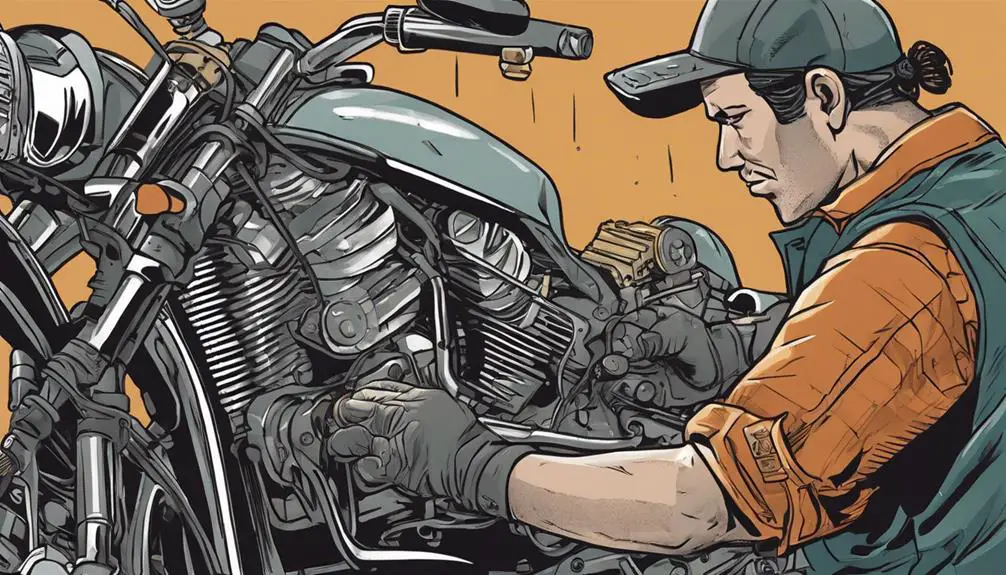
Why is regular servicing essential for your motorcycle's performance and longevity?
Think of servicing as a ritual that enables your ride. It keeps your bike in peak condition, ensuring you experience the freedom of the open road without unexpected breakdowns. When you service your motorcycle regularly, you're not just checking off a box; you're actively investing in your freedom.
Routine maintenance allows you to catch small issues before they become major problems. An oil change, brake check, or tire inspection can make all the difference in your bike's reliability and your safety. Plus, a well-maintained motorcycle runs smoother and performs better, giving you that exhilarating feeling of liberation as you cruise down winding roads.
Neglecting regular service can lead to costly repairs and, worse yet, a loss of control when you need it most. You want your motorcycle to be a trusty companion, not a burden.
Ducati Service Interval Overview
Ducati motorcycles are engineered for performance, and adhering to their recommended service intervals is vital for maintaining that exhilarating ride you love. These intervals guarantee your bike stays in peak condition and delivers the power and precision you crave on the open road.
When you own a Ducati, you'll want to keep these key service intervals in mind:
- Every 7,500 miles or annually: This is when you should have a thorough service. It's a chance to assess everything from brakes to suspension.
- Every 15,000 miles: This interval often includes valve adjustments, essential for maximum engine performance.
Engine Oil Change Schedule
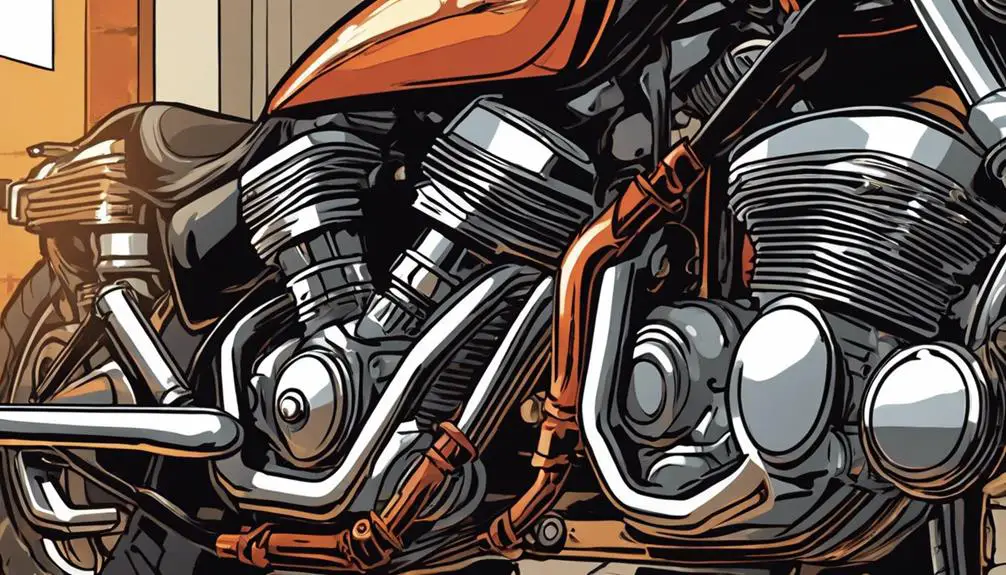
Regularly changing your engine oil is essential for keeping your motorcycle's engine running smoothly and efficiently. It helps to remove contaminants and provides proper lubrication, which ultimately extends the life of your bike.
Most motorcycle manufacturers recommend changing the oil every 3,000 to 5,000 miles, but factors like riding conditions and oil type can influence this interval. If you ride in extreme conditions—like heavy traffic, off-road, or high temperatures—you might need to change it more frequently. Synthetic oils can last longer than conventional oils, so consider your options based on your riding style and preferences.
Don't just wait for the recommended mileage; keep an eye on the oil's color and consistency. If it looks dirty or gritty, it's time for a change.
Ultimately, taking control of your motorcycle's maintenance empowers you. Regular oil changes not only enhance performance but also allow you to enjoy the freedom of the open road with confidence.
Make it a habit, and you'll experience a smoother ride while staying in tune with your machine. Embrace the rhythm of the road, knowing you're doing right by your bike!
Valve Adjustment Frequency
When it comes to valve adjustments, you should always follow your manufacturer's guidelines.
Different engine types can have varying requirements, so knowing your bike's specifics is essential.
Regular adjustments help maintain ideal performance and prevent potential issues down the road.
Manufacturer Guidelines
Most manufacturers recommend checking valve adjustments every 5,000 to 10,000 miles, depending on the specific model and engine type. Staying true to these guidelines is essential for maintaining your bike's performance and ensuring a smooth ride. Ignoring valve adjustments can lead to decreased efficiency and potential engine damage, which no rider wants.
Consider these key points when planning your maintenance:
- Follow the manual: Your motorcycle's manual is your best friend. It offers specific recommendations tailored to your ride.
- Listen to your engine: If you hear unusual sounds, it might be time for an adjustment, even if you haven't hit the mileage target.
Embracing these practices empowers you to connect with your machine on a deeper level. By respecting your manufacturer's guidelines, you're not just keeping your motorcycle in top shape; you're enhancing your freedom on the road.
Engine Type Differences
How often you need to adjust your valves can vary considerably based on your motorcycle's engine type.
If you've got a high-performance sportbike with a liquid-cooled engine, you'll likely find yourself tweaking those valves more frequently—sometimes every 6,000 to 8,000 miles. On the other hand, if you ride a cruiser with a pushrod engine, those adjustments could stretch out to 15,000 miles or more.
Air-cooled engines often require less frequent adjustments, too, since they operate at lower RPMs and generate less wear. But don't let that lull you into complacency; regular checks are still essential.
If you ride a dual-sport bike, be prepared for a mixed bag—these versatile engines can vary widely in their maintenance needs.
Ultimately, knowing your engine type empowers you to take charge of your maintenance schedule. Embrace the freedom of staying proactive!
Keep an eye on your bike's performance, and don't hesitate to consult your manual or a trusted mechanic. A well-tuned engine isn't just about performance; it's about liberating your ride and enhancing your experience on the road.
Brake System Maintenance
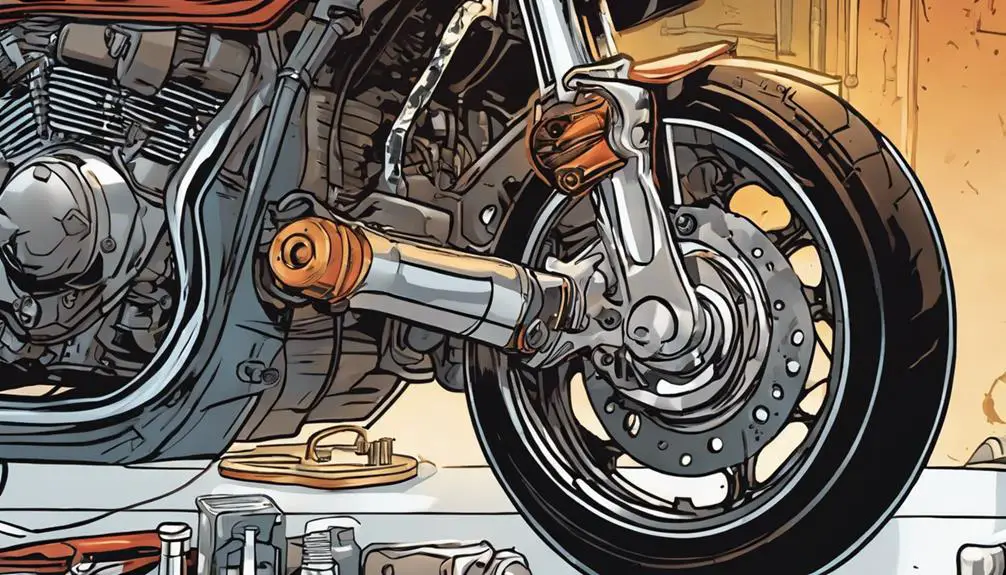
When it comes to your motorcycle's brake system, regular maintenance is essential for your safety.
You should stick to a brake fluid replacement schedule and inspect your brake pads regularly to guarantee everything's in top shape.
Ignoring these tasks can lead to serious issues on the road.
Brake Fluid Replacement Schedule
Regularly replacing your brake fluid is essential for maintaining ideal brake performance and safety on your motorcycle. The brake fluid absorbs moisture over time, which can lead to corrosion and reduced braking efficiency.
To keep your ride liberating and enjoyable, follow these guidelines for a replacement schedule:
- Change your brake fluid every 1 to 2 years, even if you don't ride often.
- Check the fluid level and condition during routine maintenance; a darker color signals it's time for a change.
Inspecting Brake Pads Regularly
Inspecting your brake pads every few months guarantees they're in good condition and ready for safe riding. You don't want anything holding you back when you're on the open road, so checking those pads is essential. Look for wear indicators, grooves, or uneven surfaces. If they're worn down to the minimum thickness, it's time for a replacement.
Don't forget to inspect the brake fluid level and lines while you're at it. If you spot any leaks or damage, address those issues immediately. Remember, your brakes are your lifeline on two wheels; you need them to respond flawlessly when you need to stop quickly.
Make it a habit to check your pads during regular maintenance, regardless of your riding frequency. If you ride hard or often, check them more frequently. Keeping your brake pads in top shape not only enhances your safety but also gives you the freedom to enjoy every twist and turn with confidence.
Tire Inspection Recommendations
You should check your motorcycle tires for wear and damage at least once a month to guarantee peak performance and safety. Tires are your only contact with the road, so keeping them in top shape is essential for your freedom on two wheels. Look for any signs that might compromise your ride.
- Tread Depth: Make sure your tread isn't worn down. Use the penny test—insert a penny into the tread; if you can see Lincoln's head, it's time for new tires.
- Sidewall Damage: Inspect for any cuts, bulges, or cracks. These can lead to blowouts, and that's the last thing you want when you're cruising down the highway.
Chain and Sprocket Care
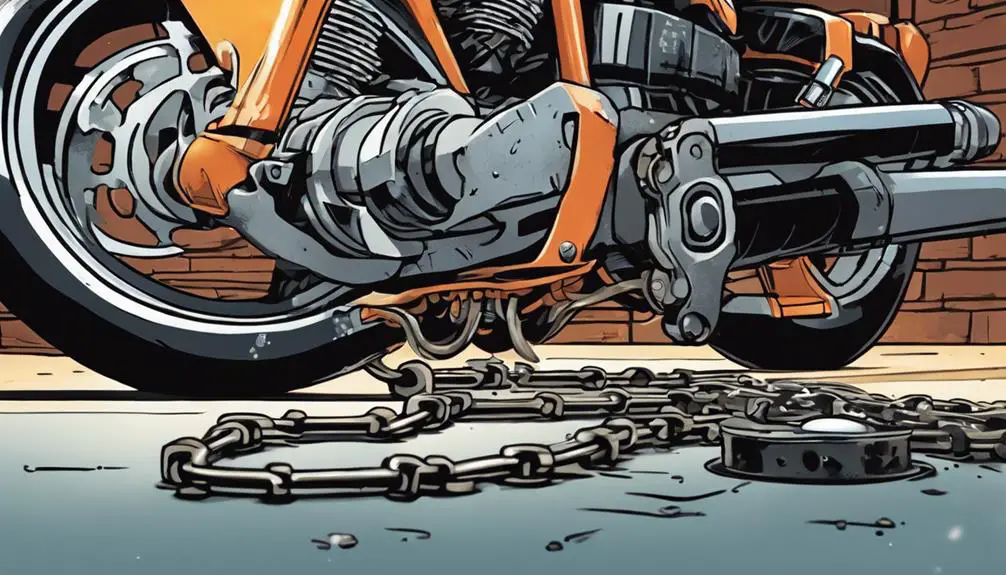
Keeping your chain and sprockets well-maintained is essential for smooth operation and ideal performance of your motorcycle. A well-lubricated chain not only enhances your ride's efficiency but also prolongs the life of your components. Regularly check for wear and tear; look for stiff links or signs of rust. If you notice any issues, don't hesitate to take action.
To keep your chain in prime condition, clean it regularly with a suitable chain cleaner and a brush. After cleaning, apply a quality chain lubricant to guarantee it operates smoothly. Aim to lubricate your chain every 300-600 miles, especially after riding in wet or dirty conditions.
Don't forget about your sprockets! Inspect them for excessive wear, like hooked teeth, which can indicate a problem. If you're replacing your chain, it's a good idea to replace the sprockets too, as they wear together.
Battery Maintenance Tips
While maintaining your chain and sprockets is important, don't overlook the health of your motorcycle's battery, as it plays a vital role in starting your bike and powering its electrical systems. A neglected battery can leave you stranded, so let's make certain it stays in top shape.
Here are some battery maintenance tips to keep your ride liberated and free:
- Check the terminals: Make sure they're clean and tight. Corrosion can hinder performance, so a quick wipe-down can go a long way.
- Maintain the water level: If you have a non-sealed battery, check the water level regularly. Top it off with distilled water when necessary; it keeps the battery operating smoothly.
Common Ducati Issues
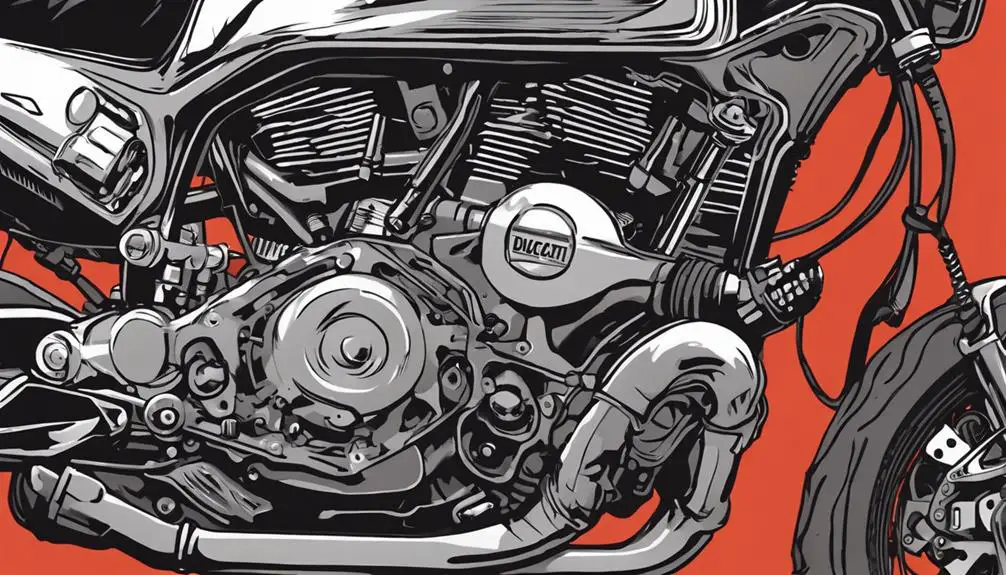
Recognizing common Ducati issues can help you address problems before they escalate, ensuring your ride remains smooth and enjoyable.
One of the most frequent issues you might encounter is the notorious fueling problem. If your bike hesitates or stutters during acceleration, it could be a sign of a clogged fuel filter or bad fuel pump.
Another common concern is the electrical system. You may experience flickering lights or difficulty starting, often caused by loose connections or a failing battery. Regular inspections can keep this from ruining your ride.
Ducati's desmodromic valve system is a marvel, but it requires precise adjustments. If you notice unusual noises or performance dips, it's time to check the valve clearance and timing belts.
Additionally, keep an eye on your cooling system. Overheating can lead to severe engine damage. Check the coolant levels and look for leaks regularly.
Seasonal Service Considerations
As the seasons change, it's essential to adjust your motorcycle maintenance routine accordingly.
In spring, you should tackle a thorough maintenance checklist to prep for the riding season.
Meanwhile, winter calls for proper storage preparations to protect your bike.
Keeping these seasonal considerations in mind will guarantee your motorcycle stays in top shape year-round.
Spring Maintenance Checklist
Before hitting the road this spring, you should run through a thorough maintenance checklist to confirm your motorcycle is in top shape.
Spring brings the thrill of open roads, but it's essential to make certain your ride is ready for adventure. Here's a quick checklist to get you started:
- Inspect Tires: Check for wear and proper inflation. Your tires are your connection to the road, so make sure they're ready to grip.
- Change Oil and Filter: Fresh oil keeps your engine running smoothly. Don't skip this step; it's important for performance and longevity.
Winter Storage Preparations
Preparing your motorcycle for winter storage is essential to confirm it stays in excellent condition during the off-season.
Start by giving your bike a thorough wash and wax to protect the paint and metal from corrosion. Once it's clean, change the oil and filter to remove contaminants that could harm the engine.
Next, fill the tank with fuel and add a fuel stabilizer to prevent it from degrading. This small step can save you headaches come spring. Don't forget to check your tire pressure and inflate them as needed; flat spots can develop if they're left under-inflated for too long.
Disconnect the battery or use a battery maintainer to keep it charged. Store your motorcycle in a cool, dry place, ideally on a stand to keep the tires off the ground. Cover it with a breathable tarp or motorcycle cover to shield it from dust and moisture.
Lastly, make a checklist for when you're ready to ride again. This way, you can confirm everything is in order before hitting the open road. With these steps, you're freeing your bike from winter's grasp, so it's ready to roar back to life!
Frequently Asked Questions
How Can I Tell if My Motorcycle Needs Immediate Servicing?
You can tell your motorcycle needs immediate servicing by paying attention to unusual sounds, vibrations, or leaks.
If your brakes feel spongy or less responsive, it's a red flag.
Check for warning lights on the dashboard; they're there for a reason.
Also, if you notice a drop in performance or handling, don't ignore it.
Trust your instincts—your ride deserves it.
Freedom on two wheels relies on keeping your machine in top shape.
What Tools Are Essential for Basic Motorcycle Maintenance?
Mastering motorcycle maintenance means you'll need some must-have tools.
Start with a sturdy socket set, a reliable torque wrench, and a trusty screwdriver set for tackling tight spots.
Don't forget your oil filter wrench and a good tire pressure gauge.
These essentials empower you to guarantee your ride runs smoothly and safely.
With the right tools, you'll liberate your motorcycle's potential and embrace the open road with confidence!
Can I Service My Motorcycle Myself or Should I Hire a Professional?
You can absolutely service your motorcycle yourself if you're willing to learn and get hands-on. It's empowering to tackle basic maintenance tasks and understand your ride better.
However, if you're unsure or uncomfortable with complex repairs, hiring a professional can guarantee safety and reliability. Trust your instincts; if you feel confident, jump in!
Just remember, there's no shame in seeking help when you need it. Your safety matters most.
How Does Riding Style Affect Service Frequency?
Your riding style can greatly impact how often you need to service your bike.
If you're a thrill-seeker, pushing your motorcycle to its limits, you'll find that wear and tear accelerates, demanding more frequent maintenance.
On the other hand, if you ride gently, you might stretch those intervals.
Understanding this connection empowers you to ride with freedom, knowing that your choices directly influence your bike's performance and longevity.
Are There Specific Seasonal Considerations for Different Motorcycle Types?
Seasonal changes can impact your motorcycle's performance and maintenance needs.
If you ride a touring bike, consider prepping it for winter storage, ensuring fluids are topped off and tires are properly inflated.
For dirt bikes, check the air filter and tires more frequently during muddy seasons.
You'll want to adjust your maintenance routines based on your bike type and the climate you're in, keeping your ride smooth and ready for adventure whenever you are!
Conclusion
In summary, keeping your motorcycle in top shape means sticking to a regular service schedule.
Change your oil, adjust your valves, check your brakes, and maintain your chain.
Don't forget your battery and seasonal needs, either.
By staying proactive with these tasks, you'll enhance performance, extend lifespan, and guarantee safety.
Remember, a well-maintained bike isn't just a ride; it's a reliable companion on every adventure.
Stay vigilant, stay safe, and enjoy the journey!